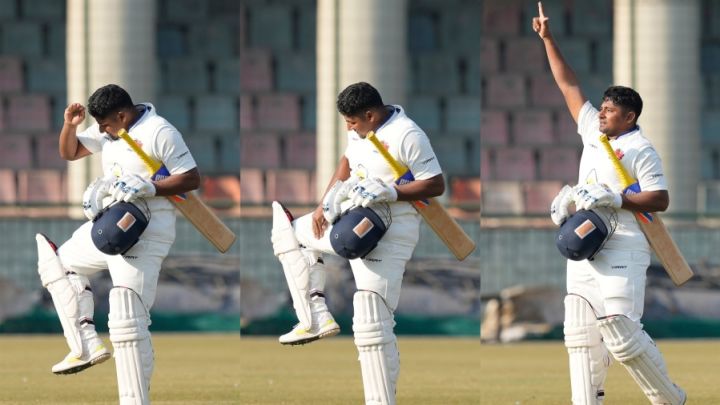Sidharth Monga

After India’s selection for the tour of the West Indies, former Test captain Sunil Gavaskar asked a pertinent question: “Sarfaraz Khan has been scoring at an average of 100 in the past three seasons. What does he have to do to be picked in the [Test] squad?”
Sarfaraz is indeed averaging 106.07 in first-class cricket since the start of 2020. The selectors are in a no-win situation here. Forget explaining Sarfaraz’s prolonged exclusion, they aren’t even allowed to say whether Mohammed Shami has been rested or is injured. So it’s tricky to tell a player like Sarfaraz that they aren’t considered good enough to play for India despite all the runs they have amassed, but it is something you hope they are doing in a sensitive manner.
However, we are not completely in the dark. There is one plausible cricketing reason for Sarfaraz’s non-selection. A pattern you can identify without a selector’s insight: of Sarfaraz’s 3505 first-class runs, 3348 have come at No. 5 or below.
Since 2006, around when ESPNcricinfo’s Statsguru added filters for batting positions in domestic first-class cricket, India have had 54 Test debutants. Among them, Karun Nair is the only specialist batter with a major chunk of his Ranji Trophy runs before his Test debut at No. 5 or below. Even Nair had moved to No. 4 in the season immediately prior to his India debut.
So none of the big performers at No. 5 or below since 2006 has gone on to play Test cricket for India as a specialist batter. Apart from Sarfaraz, that list includes Manish Pandey (average 65) and Ambati Rayudu (average 60). Those who did make it to were Ravindra Jadeja, Rishabh Pant, Wriddhiman Saha and Axar Patel. They are either allrounders or wicketkeepers batting ahead of their usual station to prove their batting prowess for Test selection.
Two interesting names in that list might tell you why first-class runs outside the top four are probably given less weightage. Ajay Jadeja and Amol Muzumdar averaged 67 and 53 in the lower-middle order but these stats are only 2005-06 onwards, indicating that they batted there only at the end of their careers. In the Ranji Trophy, a good batter bats in the lower-middle order usually at the start or the end of his career.
The common assumption is that if you don’t bat in the top four, you aren’t even among the best batters of your domestic side. You don’t face the new ball and bowlers are usually tired by the time you’re into bat. Ranji teams don’t have the depth that international bowling attacks do to challenge batters. Even if you come in at a precarious 50 for 3 – and Sarfaraz has scored runs from similar situations – the ball is likely about 15 overs old and the weaker bowlers are operating.
All the specialist batters with decently long Test careers for India have batted in the top four in domestic cricket. In all, 36 players have scored 2000-plus runs in the top seven for India. Take out the three wicketkeepers and four allrounders, and only one of the remaining 29 spent a considerable amount of time batting outside the top four in domestic first-class cricket. That man was Mansur Ali Khan Pataudi, who played a lot of his domestic cricket on the county circuit in England.
Are India’s selectors undervaluing domestic cricket?
What must Sarfaraz Khan and Abhimanyu Easwaran do to get called up? Do Ranji Trophy numbers matter anymore? The Run Order crew discuss
The general trend for a young batter in India is to start his first-class career at No. 5 or 6 and then move up the order before the national selectors come calling. A classic case perhaps is Muzumdar, a prolific batter with no Test cap, who spent a fair bit of time outside the top four for Mumbai. Quite often, he couldn’t have done much about it: he had to bat behind Sanjay Manjrekar, Sachin Tendulkar and Vinod Kambli.
In Sarfaraz’s case, there have been times when he has had to bat behind the likes of Yashasvi Jaiswal, Shreyas Iyer, Suryakumar Yadav and Ajinkya Rahane, but it hasn’t always been so. And this year a lot of those players will be away on India duty, so Sarfaraz can have the opportunity.
This is not to say that Sarfaraz is not a good batter and won’t do well against the new ball, fresh bowlers and stronger attacks, but perhaps the selectors haven’t seen enough evidence of that yet. It sounds like an extremely ruthless approach to selection, but selection in India is a ruthless job. There is so much batting talent in the country that you have to tick extra boxes to get into the best seven or eight.
Now we don’t know whether Sarfaraz has received any feedback from the selectors or the team management, but the answer to Gavaskar’s question is perhaps this. What more does Sarfaraz have to get picked in India’s Test squad? Probably bat higher in Mumbai’s line-up and give the selectors more reasons to select him. Or fewer reasons to ignore him, because the predominant narrative at the moment is that they are denying him a spot rather than giving him constructive feedback on how to earn that India Test cap.
Sidharth Monga is an assistant editor at ESPNcricinfo









